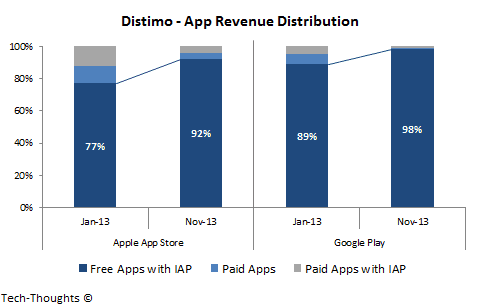Recent Posts of Costs

16 March, 2015
Augmented Reality (AR) is about overlaying pieces of a virtual world over the real world (in contrast to Virtual Reality (VR) that is about replacing the real world with a virtual one). On mobile devices, this simply means enhancing what you can see through the device’s camera with multimedia content (e.g. you can point your camera at a movie poster and watch its trailer, or you can point it at a star in the sky and learn its name). So, basically AR comes down to the following three fundamental questions: where to display what and how.

12 March, 2015
According to our latest developer research, 20% of mobile app developers primarily target enterprises. This decision produces a significant boost to their revenues, with 43% making more than $10K per month versus 19% of those who target consumers above the same revenue level. Similarly at the $100K+ per month revenue level we have 18% of developers who target enterprises versus just 7% of those who target consumers. Aside from selling to businesses, government or non-profit organisations rather than consumers, what are these developers doing differently?

09 February, 2015
For the last two and a half years I’ve been building and selling apps directly on the iOS App Store, however only in 2014 I committed to some substantial effort on this. I’d like to share some numbers about my experience last year and draw some insights about what things went well and which ones didn’t.
Hopefully this analysis will be useful to others and will give me some insight about where to focus in 2015 to grow my app revenue.

01 July, 2014
>If you’ve ever tried to integrate a mobile ad SDK into your application, then you’ve definitely had to declare a few permission for it to work. Permissions in mobile platforms such as Android and iOS have been baked in from day one as a mean to control what applications could do or access on your phone, preventing despicable people getting access to your most personal and sensitive data.

05 March, 2014
Mobile gaming is a major growth industry. Revenues and profits are soaring and the most successful companies are attracting valuations in the billions of dollars. However the market dynamics are such that very few can succeed and those that do have incentives which are a long way from maximising fun for players. Where are all the revenues coming from? Is the market fundamentally broken? If so, why aren’t the platform owners trying to fix it?

21 January, 2014
According to Distimo’s latest report, apps with “freemium” business models, i.e. free apps monetized by in-app purchases (IAP), have dominated revenue charts in 2013. This spurred me to take a deeper look at the “economics of free” and explore new opportunities for innovation in these business models. The Economics of Free Let’s begin by taking […]

08 January, 2014
Over the last decade, application testing has continually proved itself to be an important concern. When done well, testing can drastically reduce the number of bugs that make it into your release code (and thus actually affect your users). In addition, good testing approaches will help your team catch bugs earlier in the development lifecycle […]

19 November, 2013
The most popular revenue models appear to be those that are easiest to implement. The developers using them tend to have lower revenues. This may be due to greater competition or it might just be a result of less sophisticated app businesses producing less valuable apps. There are some interesting differences between platforms but subscriptions appear to be a relatively untapped gold mine everywhere, although maybe not for everyone.

24 July, 2013
Creating versions of an app for multiple platforms (at least iOS & Android) is an increasingly common requirement. Building and maintaining native code for every platform supported is both difficult and expensive. Cross-Platform Tools (CPTs) offer a solution to this problem by enabling sharing of code across platforms and in many cases a single code base can target multiple platforms. With such significant cost savings available, why don’t all developers use CPTs?

17 July, 2013
A new SDK economy has sprung up to support the needs of the 500,000+ mobile developers and the app economy. Guest author Panos Papadopoulos, CEO of Bugsense, reviews the growth and rapid consolidation of the SDK economy and the impending rise the Mega SDK vendors.